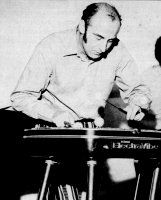
Victor Feldman
The virtues of Victor
Jam sessions
The virtues of Victor
Although he was only to be seen at Ronnie Scott’s club for one week—his shortest showing yet—Victor Feldman made a greater impression than ever. There was a general acknowledgment that Victor is a great in his own right. New factors of the Feldman performance: the predominance of piano; the exclusive use of arrangements. Appreciation was also voiced for the overall bass/ drums integration of Rick Laird and Ronnie Stephenson.
Vic Ash enthused: “To me it’s like a breath of fresh air, after some things I’ve heard recently—some good, some not so good. After this trip I’m even more convinced that Victor is one of the finest of all jazz musicians. At one time it was mostly his vibes that I listened to, but now I think his piano matches it easily. He’s the complete musician—jazzwise and technically. And Rick and Ronnie have been giving him beautiful support.”
Comparison between British and American environments was made by drummer Benny Goodman. “You can only get so much here. His approach has widened considerably since his exposure with people like Cannonball and Miles. He has greater confidence now. His music is much more academic—and I don’t mean that in a derogatory sense. Everything is well set-out. He pays a close attention to detail without losing the basic swing. Being in the States has made him very conscious of the sound and the mechanics of the music. This trio sounds like it’s been playing together for months—such close rapport. I experienced the high musical standard of his arranging when I did some TV with him. He really gets the best possible out of you. He’s tremendous.”
As a pianist Michael Garrick found many pleasing virtues in Victor’s playing. “The thing that impresses me about him is his sheer professionalism. This is emphasised by the fact that he uses arrangements now. Rick and Ronnie worked in superbly with him, adding to the glitter and sheen of the whole presentation. Victor has become a 100 per cent showman. He knows exactly what he’s going to do, where his climax is going to be placed. And he never puts a foot wrong. Someone like Sonny Rollins goes out on a limb, and perhaps tends to draw the audience after him more. In the case of Victor, it’s as if an excellent, finished product is being demonstrated before our eyes. There’s no risk of disorganisation. This probably comes from the vast amount of session work he does.
“I particularly liked his changing from 3/4 to 4/4 on “Fly Me To The Moon.” And his arrangement of “Surrey With The Fringe On Top” pleased me and involved me very much. I loved the way he used this repetitive melody line to present one or two rhythmic surprises. At the point of the harmony change towards the end of the tune, he extended the repetition of the main phrase about four bars, so that you were wondering when the final phrase was going to come. He cleverly built up your expectations, and fulfilled them at the last minute.
“You hold your breath when he jumps from vibes to piano and comes in right on the beat. He creates the effect of there being two separate musicians on the stand. He has complete familiarity with both instruments. And he plays vibes quite differently from piano. The technique doesn’t overlap. Watching Victor, I can see the dualism of the professional musician on the one hand and the soulful jazzman on the other. The two sides seem to be pulling against one another. But this doesn’t prevent him from providing peaks of excellence and engaging the attention of the audience.”